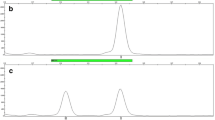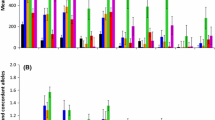Abstract
Degraded and low copy number (LCN) DNA samples are common challenging materials in forensic casework because they increase the difficulty of sample processing and reduce the possibility of obtaining genetic information from DNA. High-resolution melting (HRM) curve analysis is promising for genotyping genetic markers and has been applied to the detection of LCN and degraded DNA in the field of forensic science. However, the exact assessment based on HRM at multiple genetic markers from both degraded and LCN DNA materials has not been optimized. To explore the ability of HRM to genotype LCN and degraded DNA samples, we selected three genetic markers to genotype in experimental LCN and degraded DNA and practical hair shaft materials, which are often encountered as degraded and LCN DNA in forensic medicine. The results show that DNA samples of as low as 100 pg and as short as 60 bp were successfully genotyped by the HRM assay at all three genetic markers, whereas in hair shaft DNA, two loci were accurately genotyped. The HRM assay established in this study can be applied to LCN and degraded DNA analysis in forensic casework and can act as a reference point before genotyping short tandem repeat markers. Developing the HRM strategy for genotyping DNA genetic markers enriches detectable targets in hair shaft samples and provides valuable data for further exploration.



Similar content being viewed by others
References
Dabney J, Meyer M, Pääbo S. (2013) Ancient DNA damage , Cold Spring Harb Perspect Biol 5(7)
Giardina E, Pietrangeli I, Martone C, Zampatti S, Marsala P, Gabriele L, Ricci O, Solla G, Asili P, Arcudi G, Spinella A, Novelli G (2009) Whole genome amplification and real-time PCR in forensic casework. BMC Genomics 10:159
Marshall PL, King JL, Budowle B (2015) Utility of amplification enhancers in low copy number DNA analysis. Int J Legal Med 129:43–52
Ohira H, Sakamoto Y, Yamamoto I, Yamada Y (2018) DNA analysis of hairs in a suspected case of child abuse. Leg Med (Tokyo) 35:77–79
Pośpiech E, Chen Y, Kukla-Bartoszek M, Breslin K, Aliferi A, Andersen JD, Ballard D, Chaitanya L, Freire-Aradas A, van der Gaag KJ, Girón-Santamaría L, Gross TE, Gysi M, Huber G, Mosquera-Miguel A, Muralidharan C, Skowron M, Carracedo Á, Haas C, Morling N, Parson W, Phillips C, Schneider PM, Sijen T, Syndercombe-Court D, Vennemann M, Wu S, Xu S, Jin L, Wang S, Zhu G, Martin NG, Medland SE, Branicki W, Walsh S, Liu F, Kayser M (2018) Towards broadening forensic DNA phenotyping beyond pigmentation: improving the prediction of head hair shape from DNA. Forensic Sci Int Genet 37:241–251
Parson W, Huber G, Moreno L, Madel MB, Brandhagen MD, Nagl S, Xavier C, Eduardoff M, Callaghan TC, Irwin JA (2015) Massively parallel sequencing of complete mitochondrial genomes from hair shaft samples. Forensic Sci Int Genet 15:8–15
Linch CA (2009) Degeneration of nuclei and mitochondria in human hairs. J Forensic Sci 54:346–349
McNevin D, Wilson-Wilde L, Robertson J, Kyd J, Lennard C (2005) Short tandem repeat (STR) genotyping of keratinised hair. Part 2. An optimised genomic DNA extraction procedure reveals donor dependence of STR profiles. Forensic Sci Int 153:247–259
Nilsson M, Grånemo J, Buś MM, Havsjö M, Allen M (2016) Comparison of DNA polymerases for improved forensic analysis of challenging samples. Forensic Sci Int Genet 24:55–59
Cavanaugh SE, Bathrick AS (2018) Direct PCR amplification of forensic touch and other challenging DNA samples: a review. Forensic Sci Int Genet 32:40–49
Nicklas JA, Noreault-Conti T, Buel E (2012) Development of a fast, simple profiling method for sample screening using high resolution melting (HRM) of STRs. J Forensic Sci 57:478–488
Venables SJ, Mehta B, Daniel R, Walsh SJ, van Oorschot RA, McNevin D (2014) Assessment of high resolution melting analysis as a potential SNP genotyping technique in forensic casework. Electrophoresis 35:3036–3043
Deng JQ, Liu BQ, Wang Y, Liu W, Cai JF, Long R, Li WH (2016) Y-STR genetic screening by high-resolution melting analysis. Genet Mol Res 5:15
Vossen RH, Aten E, Roos A, den Dunnen JT (2009) High-resolution melting analysis (HRMA): more than just sequence variant screening. Hum Mutat 30:860–866
Jiang E, Yu P, Zhang S, Li C, Ding M, Wang B, Pang H (2017) Establishment of an alternative efficiently genotyping strategy for human ABO gene. Leg Med (Tokyo) 29:72–76
Zhang Z, Wang BJ, Guan HY, Pang H, Xuan JF (2009) A LDR-PCR approach for multiplex polymorphisms genotyping of severely degraded DNA with fragment sizes <100 bp. J Forensic Sci 54:1304–1309
Swango KL, Timken MD, Chong MD, Buoncristiani MR (2006) A quantitative PCR assay for the assessment of DNA degradation in forensic samples. Forensic Sci Int 158:14–26
Burnside ES, Bintz BJ, Wilson MR (2013) Improved extraction efficiency of human mitochondrial DNA from hair shafts and its implications for sequencing of the entire mtGenome from a single hair fragment. Proc Am Acad Forensic Sci 19:63
Pineda GM, Montgomery AH, Thompson R, Indest B, Carroll M, Sinha SK (2014) Development and validation of InnoQuant™, a sensitive human DNA quantitation and degradation assessment method for forensic samples using high copy number mobile elements Alu and SVA. Forensic Sci Int Genet 13:224–235
Schmidt U, Hulkkonen J, Naue J (2016) Detection of a G>C single nucleotide polymorphism within a repetitive DNA sequence by high-resolution DNA melting. Int J Legal Med 130:1181–1184
Ginart S, Caputo M, Alechine E, Corach D, Sala A (2016) Development of a quantitation approach for total human and male DNA based on real time PCR followed by high resolution melting analysis. Electrophoresis 37:2734–2741
Hamano Y, Manabe S, Morimoto C, Fujimoto S, Ozeki M, Tamaki K (2016) Forensic age prediction for dead or living samples by use of methylation-sensitive high resolution melting. Leg Med (Tokyo) 21:5–10
Mehta B, Daniel R, McNevin D (2017) HRM and SNaPshot as alternative forensic SNP genotyping methods. Forensic Sci Med Pathol 13:293–301
Madel MB, Niederstätter H, Parson W (2016) TriXY-homogeneous genetic sexing of highly degraded forensic samples including hair shafts. Forensic Sci Int Genet 25:166–174
Graham EA (2008) DNA reviews: low level DNA profiling. Forensic Sci Med Pathol 4:129–131
Moretti TR, Baumstark AL, Defenbaugh DA, Keys KM, Smerick JB, Budowle B (2001) Validation of short tandem repeats (STRs) for forensic usage: performance testing of fluorescent multiplex STR systems and analysis of authentic and simulated forensic samples. J Forensic Sci 46:647–660
Moretti TR, Baumstark AL, Defenbaugh DA, Keys KM, Brown AL, Budowle B (2001) Validation of STR typing by capillary electrophoresis. J Forensic Sci 46:661–676
Álvarez-Sandoval BA, Manzanilla LR, Montiel R (2014) Sex determination in highly fragmented human DNA by high-resolution melting (HRM) analysis. PLoS One 9:e104629
Hughes-Stamm SR, Ashton KJ, van Daal A (2011) Assessment of DNA degradation and the genotyping success of highly degraded samples. Int J Legal Med 125(3):341–348
Funding
The present study was supported by grant from the National Natural Science Foundation of China (grant no. 81471826).
Author information
Authors and Affiliations
Corresponding author
Ethics declarations
Conflict of interest
The authors declare that they have no conflict of interest.
Ethical approval
All procedures performed in studies involving human participants were in accordance with the ethical standards of the institutional and/or national research committee and with the 1964 Helsinki declaration and its later amendments or comparable ethical standards.
Additional information
Publisher’s note
Springer Nature remains neutral with regard to jurisdictional claims in published maps and institutional affiliations.
Electronic supplementary material
ESM 1
(XLSX 18 kb)
Fig. S1
PCR efficiencies of c.261delG (a) and c.803G>C (b) in the ABO gene and a 3-bp insertion in the AMELY gene (c) (PNG 174 kb)
Fig. S2
Genotyping result of a 3-bp insertion with mixed X- and Y-chromosome-specific reverse primers, using a gDNA template (a), LCN template (b), or degraded template (c). The PCR efficiencies are given (d) (PNG 318 kb)
Rights and permissions
About this article
Cite this article
Jiang, E., Zhang, S. & Pang, H. Genotyping genetic markers from LCN and degraded DNA by HRM and their application in hair shaft. Int J Legal Med 134, 31–37 (2020). https://doi.org/10.1007/s00414-019-02045-w
Received:
Accepted:
Published:
Issue Date:
DOI: https://doi.org/10.1007/s00414-019-02045-w




